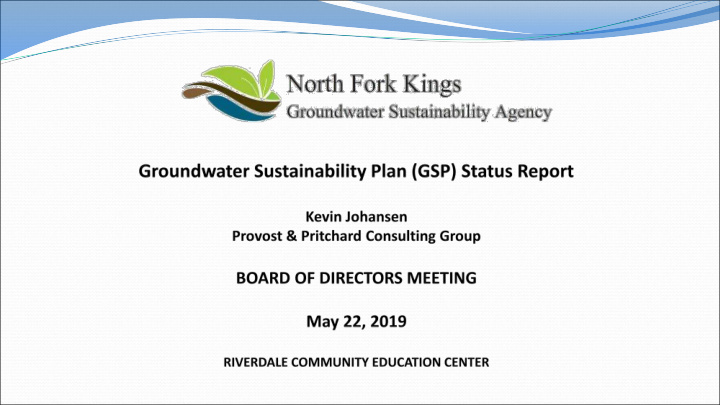



Presentation Overview 1. Schedule 2. Kings Subbasin Coordination 3. GSP Development Update 4. Water Budgets 5. Sustainable Management Criteria
All Kings GSPs Complete GSP Submittal Deadline Target Draft GSP Public Review of GSP Preparation Review GSPs and Period / Stakeholder Coordination of required Approval in Outreach / common elements amongst each GSA Revisions GSAs October 2017 Jan 31, 2020 May 2019 July 2019 6 months 2 months 18 months May 2019 GSP Preparation and Coordination Timeline
Draft GSP Review Schedule
Kings Subbasin Coordination • All GSAs within Kings Subbasin working together to coordinate activities • Work continues on coordinated plan sections regarding Kings Subbasin: Water Budget o Sustainable Management Criteria o • Work continues on developing Coordination Agreement
GSP Development Update GSP Section Current Status Future Work 1 – Introduction In Progress Complete Draft, submit to TAG in May 2 – Plan Area Draft Complete – comments incorporated Draft Provided to Board of Directors 3.1 – Hydrogeologic Conceptual Draft Complete – submitted to Technical Incorporate TAG review comments Model Advisory Group (TAG) 3.2 – Historical GW Conditions Draft Complete – submitted to TAG Incorporate TAG review comments 3.3 – Water Budget Draft Complete – being submitted to TAG Incorporate TAG review comments 4 – Sustainable Management Criteria In Progress – developing criteria for water Develop criteria, define undesirable results, levels as key component for determining set measurable objectives and minimum sustainability thresholds. Submit Draft to TAG in May. 5 – Monitoring Network Draft Complete – submitted to TAG Incorporate TAG review comments 6 – Projects and Management Actions In Progress – identifying potential projects and Complete Draft, submit to TAG in May management actions 7 – Plan Implementation In Progress – identifying implementation costs Complete Draft, submit to TAG in May and schedule
Water Budgets Historical, Current and Future Water Budgets are required by SGMA as part of GSP Water demand not met by surface water or precipitation is met by groundwater pumping Surface water supply within NFKGSA almost exclusively Kings River Approximately 22% of NFKGSA area is outside Kings River service area
Water Budget Components • Summarize hydrologic interactions Groundwater interactions: Groundwater pumping, deep percolation, intentional o recharge, river/canal seepage o Atmosphere Interactions: Precipitation, evaporation, crop ET • Summarize all water sources (inputs) and water uses (outputs) Inputs: Surface water, precipitation, groundwater pumping (estimate), o groundwater inflow Outputs: Irrigation, municipal, residential, industrial, groundwater outflow o • Calculate change in groundwater storage = Inputs – Outputs Water into groundwater system minus water out of groundwater system o
Water Budget Diagram
Simplified Basin Water Budget Diagram
Draft Historical Water Budget (Oct 1996 – Sept 2011) simplified version referred to as Basin Water Budget Confidence intervals (error %) indicate relative uncertainty of components
Summary Comparison of Draft Historical Water Budget and Draft Current Water Budget
Summary Comparison of Draft Early Future Water Budget and Draft Late Future Water Budget
Sustainable Management Criteria Sustainability indicators Significant & Unreasonable – defined using the following: • Undesirable Results Must be agreed to, and Likely • Minimum Thresholds be consistent in the addressed • Measurable Objectives GSPs of all GSAs in this order • Sustainability Goal within basin
Assessing Impact of Lowering Groundwater Levels
DRAFT
DRAFT
DRAFT
Box and Whisker Plots The box portion of the plot shows the upper and lower quartiles and represent the likely variation of the data set. The difference between the upper and lower quartile values is known as the inter- quartile range. The mean value of a data set is the sum of all the data point values divided by the number of data points in the set. This value is shown as an “X’ in the plot. The median value is the value of the data point in the middle of a data set that has been sorted sequentially from smallest to largest. The upper extreme and the lower extreme are called the whiskers.
DRAFT This may suggest lowering of groundwater levels may not impart a significant change in arsenic levels but may give cause for elevated concern if water within the areas of lower concentrations is withdrawn.
DRAFT The 2011 spike in concentration is attributed to a single elevated data point which is not considered reliable as subsequent samples did not have detections of lead for this particular well. Change in concentrations relative to time show slight variation, and overall shows the Plan Area is well below the AL for Lead
Lowering of Groundwater Levels
Measurable Objective Development Lowering of Groundwater Levels
Measurable Objective Development Lowering of Groundwater Levels
Measurable Objective Development Lowering of Groundwater Levels
Lowering of Groundwater Levels
Lowering of Groundwater Levels
Achieving Sustainability There are basically only two ways to achieve sustainability and eliminate overdraft: Increase water supply – primarily through project development o Reduce water demand – primarily through management actions o Increasing water supply will be the emphasis, but there are hurdle to overcome Preliminary project list continues to be updated and contains recharge projects that would yield an estimated annual average of approx. 50,000 AF/yr based on historic floodwater availability The amount of overdraft that can’t be overcome with increasing the water supply will need to be overcome with management actions that reduce water demand Demand reduction through management actions will likely need to be initiated within 5 - 10 years if project development is not progressing as needed
Continuing efforts after GSP adoption Jan. 2020 1. Improving monitoring networks and filling data gaps 2. Exploration of primary clay layer extents and thickness 3. Method for determining pumping volumes from various aquifers 4. Data management system development 5. Funding mechanisms for project development & implementation 6. Discussion and possible adoption of potential management actions
Recommend
More recommend